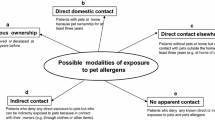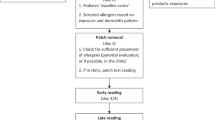Abstract
Many parents seek healthcare advice regarding whether keeping a household pet may be detrimental to the health of children with atopic eczema. Based on an extensive literature review, this article summarizes the evidence for recommendations regarding pets in households with children with eczema. The majority of studies did not provide definitive evidence on whether or not families with children with atopic eczema should get rid of their pets. The severity of atopic eczema and health-related quality of life do not directly correlate with skin sensitization to cats or dogs. Sensitized patients, especially those with concomitant asthma and severe symptoms, may consider non-furry pet alternatives if they plan to have a pet. Given the lack of good evidence, highly sensitized individuals, particularly those with asthma comorbidity, may need to remove their pet for a trial period to determine if symptoms improve in the absence of their pet.
Similar content being viewed by others
References
Leung AK, Hon KL, Robson WL. Atopic dermatitis. Adv Pediatr. 2007;54:241–73.
Hon K, Kam WY, Lam M, et al. CDLQI, SCORAD and NESS: are they correlated? Qual Life Res. 2006;15(10):1551–8.
Hon KL, Wang SS, Pong NH, et al. Circulating immunoglobulins, leucocytes and complements in childhood-onset atopic eczema. Indian J Pediatr. 2013;80(2):128–31.
Hon KL, Wang SS, Leung TF. The atopic march: from skin to the airways. Iran J Allergy Asthma Immunol. 2012;11(1):73–7.
Hon KL, Yong V, Leung TF. Research statistics in atopic eczema: what disease is this? Ital J Pediatr. 2012;38(1):26.
Hon KL, Leung TF, Lam MC, et al. Which aeroallergens are associated with eczema severity? Clin Exp Dermatol. 2007;32(4):401–4.
Hon KL. Patterns of food and aeroallergen sensitization in childhood eczema. Acta Paediatr. 2008;97(12):1734–7.
Hon KL, Chan IH, Chow CM, et al. Specific IgE of common foods in Chinese children with eczema. Pediatr Allergy Immunol. 2011;22(1 Pt 1):50–3.
Hon KL, Wang SS, Wong WL, et al. Skin prick testing in atopic eczema: atopic to what and at what age? World J Pediatr. 2012;8(2):164–8.
Hon KL, Leung TF, Kam WY, et al. Dietary restriction and supplementation in children with atopic eczema. Clin Exp Dermatol. 2006;31(2):187–91.
Hon KL, Leung TF, Lam MC, et al. Eczema exacerbation and food atopy beyond infancy: how should we advise Chinese parents about dietary history, eczema severity, and skin prick testing? Adv Ther. 2007;24(2):223–30.
Hon KL, Poon TC, Pong NH, et al. Specific IgG and IgA of common foods in Chinese children with eczema: friend or foe. J Dermatolog Treat. 2014;25(6):462–6.
Munivrana SH, Plavec D, Munivrana S, et al. Prevalence of and risk factors for the development of atopic dermatitis in schoolchildren aged 12-14 in northwest Croatia. Allergol Immunopathol (Madr). 2014;42(2):142–8.
Liccardi G, Salzillo A, Piccolo A, et al. Is there any relationship between allergic sensitization to milk and animal allergens in atopic adults? Eur Ann Allergy Clin Immunol. 2012;44(3):141–3.
Dharmage SC, Lodge CL, Matheson MC, et al. Exposure to cats: update on risks for sensitization and allergic diseases. Curr Allergy Asthma Rep. 2012;12(5):413–23.
Gaffin JM, Spergel JM, Boguniewicz M, et al. Effect of cat and daycare exposures on the risk of asthma in children with atopic dermatitis. Allergy Asthma Proc. 2012;33(3):282–8.
Farmaki R, Saridomichelakis MN, Leontides L, et al. Dust mite species in the households of mite-sensitive dogs with atopic dermatitis. Vet Dermatol. 2012;23(3):222-e45.
Von KL, Svensson A, Apfelbacher C, et al. Factors that predict remission of infant atopic dermatitis: a systematic review. Acta Derm Venereol. 2014;10–1941.
Baek JO, Hong S, Son DK, et al. Analysis of the prevalence of and risk factors for atopic dermatitis using an ISAAC questionnaire in 8,750 Korean children. Int Arch Allergy Immunol. 2013;162(1):79–85.
Sandilands A, Smith FJ, Irvine AD, et al. Filaggrin’s fuller figure: a glimpse into the genetic architecture of atopic dermatitis. J Invest Dermatol. 2007;127:1282–4.
Sandilands A, Terron-Kwiatkowski A, Hull PR, et al. Comprehensive analysis of the gene encoding filaggrin uncovers prevalent and rare mutations in ichthyosis vulgaris and atopic eczema. Nat Genet. 2007;39(5):650–4.
Ching G, Hon KL. Filaggrin null mutations in childhood atopic dermatitis among the Chinese. Int J Immunogenet. 2009;36(4):251–4.
Strachan DP. Family size, infection and atopy: the first decade of the “hygiene hypothesis”. Thorax. 2000;55(Suppl 1):S2–10.
de Benedictis FM, Franceschini F, Hill D, et al. The allergic sensitization in infants with atopic eczema from different countries. Allergy. 2009;64(2):295–303.
Clausen M, Kristjansson S, Haraldsson A, et al. High prevalence of allergic diseases and sensitization in a low allergen country. Acta Paediatr. 2008;97(9):1216–20.
Peroni DG, Piacentini GL, Bodini A, et al. Prevalence and risk factors for atopic dermatitis in preschool children. Br J Dermatol. 2008;158(3):539–43.
Nemoto-Hasebe I, Akiyama M, Nomura T, et al. Clinical severity correlates with impaired barrier in filaggrin-related eczema. J Invest Dermatol. 2009;129(3):682–9.
Marinho S, Simpson A, Lowe L, et al. Rhinoconjunctivitis in 5-year-old children: a population-based birth cohort study. Allergy. 2007;62(4):385–93.
Prodanovic H, Raherison C, Vernejoux JM, et al. Does the presence of a pet at home influence the prevalence of asthma and rhinitis? [in French]. Rev Mal Respir. 2002;19(6):735–40.
Kahwa EK, Waldron NK, Younger NO, et al. Asthma and allergies in Jamaican children aged 2–17 years: a cross-sectional prevalence survey. BMJ Open. 2012;2(4):e001132.
Batlles-Garrido J, Torres-Borrego J, Rubi-Ruiz T, et al. Prevalence and factors linked to allergic rhinitis in 10 and 11-year-old children in Almeria. Isaac Phase II, Spain. Allergol Immunopathol (Madr). 2010;38(3):135–41.
Schafer T, Heinrich J, Wjst M, et al. Association between severity of atopic eczema and degree of sensitization to aeroallergens in schoolchildren. J Allergy Clin Immunol. 1999;104(6):1280–4.
Schafer T, Heinrich J, Wjst M, et al. Indoor risk factors for atopic eczema in school children from East Germany. Environ Res. 1999;81(2):151–8.
Pelucchi C, Galeone C, Bach JF, et al. Pet exposure and risk of atopic dermatitis at the pediatric age: a meta-analysis of birth cohort studies. J Allergy Clin Immunol. 2013;132(3):616–22.
Flohr C, Yeo L. Atopic dermatitis and the hygiene hypothesis revisited. Curr Probl Dermatol. 2011;41:1–34.
Biagini Myers JM, Wang N, et al. Genetic and environmental risk factors for childhood eczema development and allergic sensitization in the CCAAPS cohort. J Invest Dermatol. 2010;130(2):430–7.
Bisgaard H, Simpson A, Palmer CN, et al. Gene-environment interaction in the onset of eczema in infancy: filaggrin loss-of-function mutations enhanced by neonatal cat exposure. PLoS Med. 2008;5(6):e131.
Langan SM, Flohr C, Williams HC. The role of furry pets in eczema: a systematic review. Arch Dermatol. 2007;143(12):1570–7.
Gern JE, Reardon CL, Hoffjan S, et al. Effects of dog ownership and genotype on immune development and atopy in infancy. J Allergy Clin Immunol. 2004;113(2):307–14.
Nafstad P, Magnus P, Gaarder PI, et al. Exposure to pets and atopy-related diseases in the first 4 years of life. Allergy. 2001;56(4):307–12.
Author information
Authors and Affiliations
Corresponding author
Ethics declarations
Funding
This review was not financially supported by any external sources
Conflict of interest
Kam Lun Hon, Yin Ching Kathy Tsang, Nga Hin Henry Pong, Ting Fan Leung declare that they have no conflicts of interest
Rights and permissions
About this article
Cite this article
Hon, K.L., Tsang, Y.C.K., Pong, N.H.H. et al. Childhood eczema and household pets: a literature review. Drugs Ther Perspect 32, 484–487 (2016). https://doi.org/10.1007/s40267-016-0348-8
Published:
Issue Date:
DOI: https://doi.org/10.1007/s40267-016-0348-8




